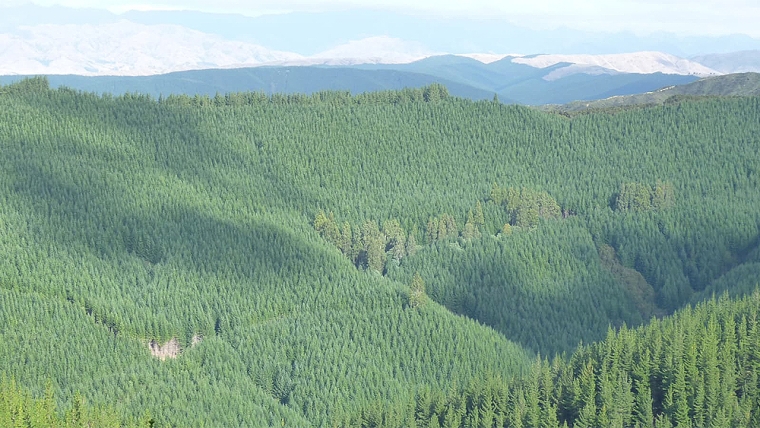
The National Environmental Standards for Plantation Forestry (NES-PF) were established in 2018 to create nationally consistent regulatory conditions for plantation forests. Since the NES-PF, there has been an increase in carbon forest planting, which did not previously face any management requirements. The negative effects of carbon forests can be substantial especially when it comes to fire, pest, and disease spread.
The new rules came out last week and mean that carbon forests have to face the same requirements as forests intended for clear-fell harvest. This helps to reduce some, but not all, of the risks posed to the natural environment or rural communities.
Looking forward, carbon foresters must plan out how they will meet environmental requirements for stream crossings, sediment loss from limited harvests, and access track drainage among other things. These requirements already exist for plantation foresters.
The new regulations also enable councils to consider more factors when making rules about forestry in their plans, including location and scale. This could include the impact on the community as a result of the land use change. Councils will be making changes to their District and Regional plans over the next 5 years to enact these powers.
The regulations are now called the National Environmental Standards for Commercial Forestry (NES-CF). They were previously called the National Environmental Standards for Plantation Forestry (NES-PF).
These changes aim to enhance the management of risks and impacts associated with carbon forestry. While further adjustments are still required in the New Zealand Emissions Trading Scheme (NZ ETS) framework, as it constitutes the fundamental legislation influencing land-use alterations, these rule modifications signify a positive stride in the right direction.
A notable concern lies in the absence of mandatory provisions compelling carbon foresters to mitigate the risks posed by wildfires, diseases, or pest infestations. These hazards have gained increasing prominence in a progressively warming world. Potential changes aimed at addressing these concerns within the eligibility criteria for the 'permanent forest' category in the NZ ETS are under consideration, though the timeline and certainty of their implementation remain unclear.
It's important to note that these amendments may not have an immediate effect on the ongoing loss of productive sheep and beef country to carbon forestry. Nevertheless, they do go a long way to establish parity, ensuring that carbon foresters bear the same responsibilities as other land users when engaging in their activities.
Carbon farming and offsetting have become increasingly popular mechanisms for businesses to address their carbon footprint. While they have their merits and can play a role in climate mitigation, they should not be viewed as a silver bullet for driving genuine and substantial emission reductions, nor should carbon farming come at the expense of food security and export revenue for New Zealand. Here are some points on why carbon farming and offsetting may fall short in encouraging businesses, such as airlines, to make meaningful changes in their emission-reduction efforts.
Emission Reduction vs. Compensation:
Carbon offsetting should ideally complement, not substitute for efforts to reduce emissions at their source. What we see is businesses like airlines or any industry for that matter that relies on fossil fuels, might view offsets as an easy way out, allowing them to continue their emissions-intensive operations without making any fundamental changes. This leads to a false sense of environmental responsibility without actually curbing emissions.
Emission Additionality:
The concept of additionality is crucial in assessing the effectiveness of offset schemes. It means that offset schemes should lead to emission reductions that wouldn't have occurred otherwise. In reality, some offset projects might not meet this criteria. They could be "business as usual" activities, or they might not generate the claimed emission reductions, thereby undermining the entire concept of offsetting.
Double Counting:
The carbon offset market can be murky, with the risk of double counting emissions reductions. In some cases, the same emission reductions are claimed by multiple parties, which inflates the perceived impact of offsetting. This undermines the integrity of offset mechanisms and can lead to a false impression of progress.
Moral Hazard:
The availability of offsetting options can create a moral hazard by reducing the incentive for businesses to reduce their emissions directly. If a company can simply buy offsets to neutralize its emissions, it may lack motivation to invest in cleaner technologies or change its practices to minimize its carbon footprint.
Limited Scope:
Carbon farming and offsetting tend to focus on specific activities or sectors, which may not comprehensively address the broader challenges of emissions reduction. Many emission sources, such as those in heavy industry or transportation, are not easily amenable to offsetting solutions, making it essential to prioritize direct emissions reduction strategies.
Global vs. Local Impact:
Offset projects often occur in different geographical locations from the emissions they are meant to compensate for. This can result in a lack of local environmental benefits and may even contribute to environmental injustices by burdening marginalized communities with pollution.
Uncertainty and Long-Term Commitment:
arbon offset projects can be uncertain and may not guarantee long-term emission reductions. Forests, for instance, can be vulnerable to fire, disease, or deforestation, which could release stored carbon back into the atmosphere. This makes offsetting a less reliable mechanism for achieving enduring emission reductions.
While carbon farming and offsetting have a place in the climate action toolkit, they should not serve as a carte blanche for businesses to continue emitting greenhouse gases without making substantial, direct emission reductions.
It's crucial for businesses, especially major emitters like airlines, to prioritize internal emission reductions through technological advancements, operational changes, and sustainable practices. Offset mechanisms should be viewed as a complementary measure and better still, part of a diverse farming system rather than a primary means of addressing climate change and putting rural communities and food security at risk.
Genuine and lasting change in emission reductions will require more profound and sustained efforts across all sectors of the economy.
Listen to the podcast to hear the full version.
Angus Kebbell is the Producer at Tailwind Media. You can contact him here.

We welcome your comments below. If you are not already registered, please register to comment.
Remember we welcome robust, respectful and insightful debate. We don't welcome abusive or defamatory comments and will de-register those repeatedly making such comments. Our current comment policy is here.